Analysis of Operations, Logistics, and Supply Chain at Toyota
VerifiedAdded on 2020/06/06
|9
|2790
|46
Report
AI Summary
This report provides a comprehensive analysis of operations, logistics, and supply chain management, using Toyota as a case study. It begins with an overview of Toyota's operations and then delves into the critical review of relevant theories in operations, logistics, and supply chain management. The report examines various aspects, including transportation, inventory management, and the application of the 7 R's of logistics. Furthermore, it explores the significance of supply chain management, emphasizing the importance of employee engagement and training. The report then discusses analytic examples and applies appropriate solutions of operations management, such as Six Sigma, Lean Manufacturing, Total Quality Management, and Human Capital Management, and the Toyota Production System. The conclusion summarizes the key findings and offers recommendations for improving Toyota's operations. The report highlights the importance of effective operations management for achieving business success.
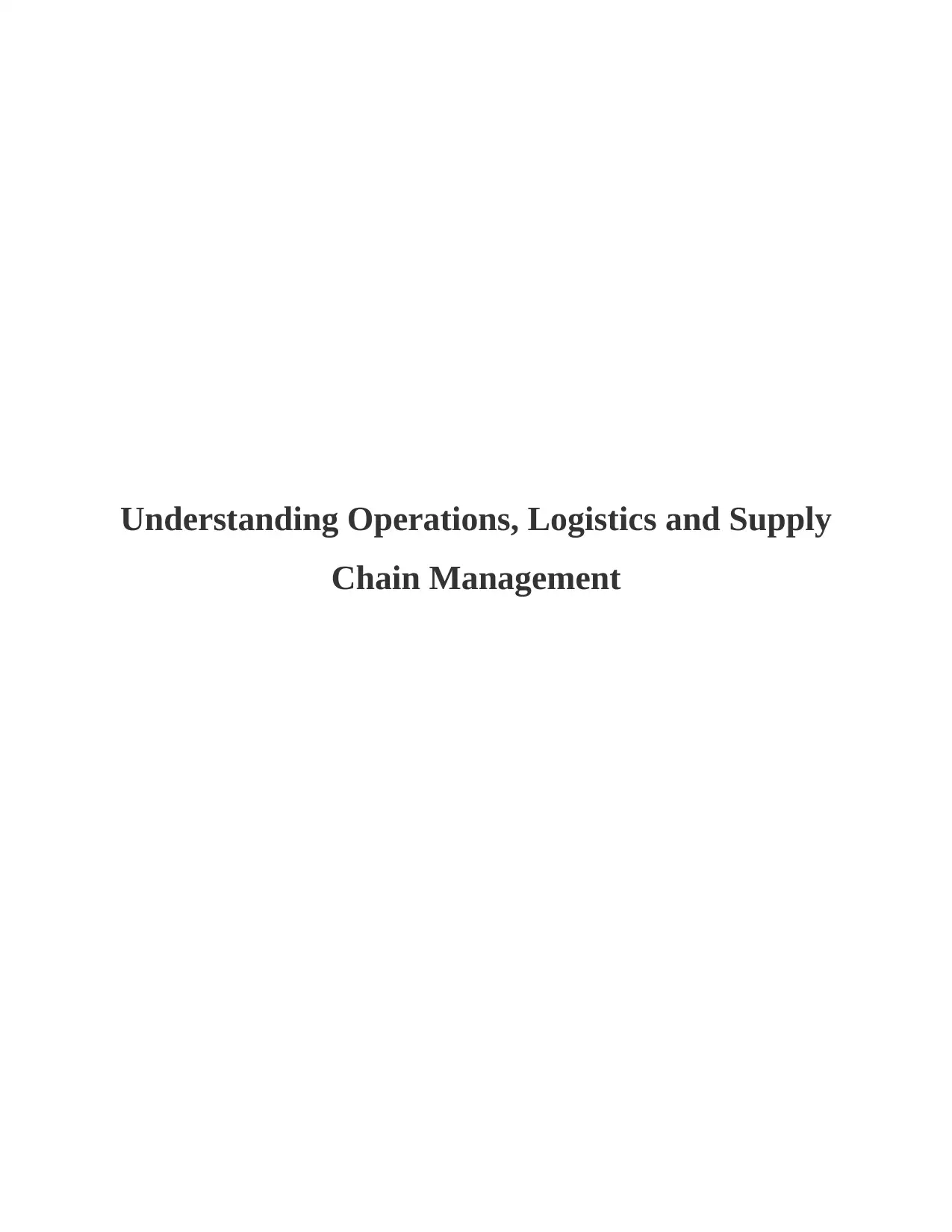
Understanding Operations, Logistics and Supply
Chain Management
Chain Management
Paraphrase This Document
Need a fresh take? Get an instant paraphrase of this document with our AI Paraphraser
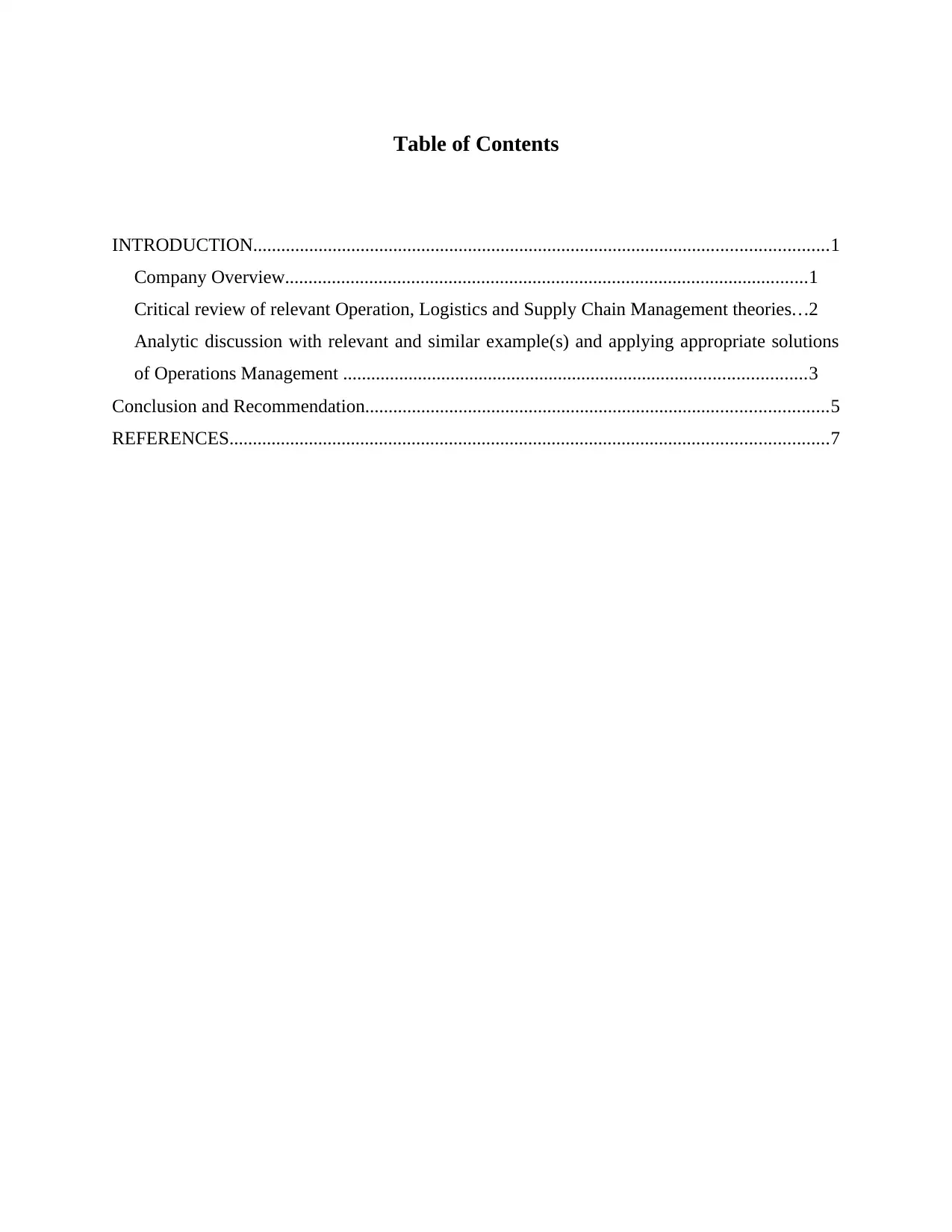
Table of Contents
INTRODUCTION...........................................................................................................................1
Company Overview................................................................................................................1
Critical review of relevant Operation, Logistics and Supply Chain Management theories...2
Analytic discussion with relevant and similar example(s) and applying appropriate solutions
of Operations Management ...................................................................................................3
Conclusion and Recommendation...................................................................................................5
REFERENCES................................................................................................................................7
INTRODUCTION...........................................................................................................................1
Company Overview................................................................................................................1
Critical review of relevant Operation, Logistics and Supply Chain Management theories...2
Analytic discussion with relevant and similar example(s) and applying appropriate solutions
of Operations Management ...................................................................................................3
Conclusion and Recommendation...................................................................................................5
REFERENCES................................................................................................................................7
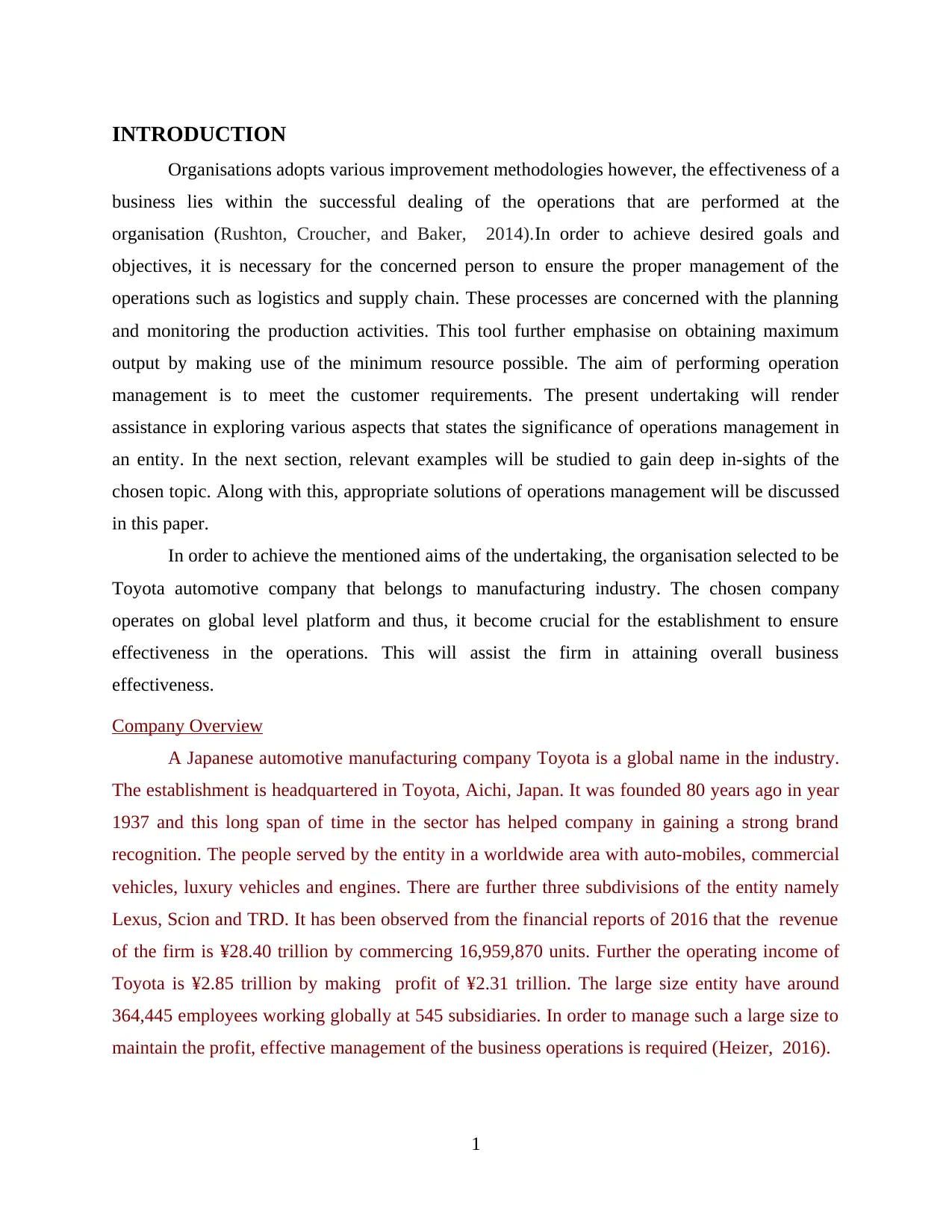
INTRODUCTION
Organisations adopts various improvement methodologies however, the effectiveness of a
business lies within the successful dealing of the operations that are performed at the
organisation (Rushton, Croucher, and Baker, 2014).In order to achieve desired goals and
objectives, it is necessary for the concerned person to ensure the proper management of the
operations such as logistics and supply chain. These processes are concerned with the planning
and monitoring the production activities. This tool further emphasise on obtaining maximum
output by making use of the minimum resource possible. The aim of performing operation
management is to meet the customer requirements. The present undertaking will render
assistance in exploring various aspects that states the significance of operations management in
an entity. In the next section, relevant examples will be studied to gain deep in-sights of the
chosen topic. Along with this, appropriate solutions of operations management will be discussed
in this paper.
In order to achieve the mentioned aims of the undertaking, the organisation selected to be
Toyota automotive company that belongs to manufacturing industry. The chosen company
operates on global level platform and thus, it become crucial for the establishment to ensure
effectiveness in the operations. This will assist the firm in attaining overall business
effectiveness.
Company Overview
A Japanese automotive manufacturing company Toyota is a global name in the industry.
The establishment is headquartered in Toyota, Aichi, Japan. It was founded 80 years ago in year
1937 and this long span of time in the sector has helped company in gaining a strong brand
recognition. The people served by the entity in a worldwide area with auto-mobiles, commercial
vehicles, luxury vehicles and engines. There are further three subdivisions of the entity namely
Lexus, Scion and TRD. It has been observed from the financial reports of 2016 that the revenue
of the firm is ¥28.40 trillion by commercing 16,959,870 units. Further the operating income of
Toyota is ¥2.85 trillion by making profit of ¥2.31 trillion. The large size entity have around
364,445 employees working globally at 545 subsidiaries. In order to manage such a large size to
maintain the profit, effective management of the business operations is required (Heizer, 2016).
1
Organisations adopts various improvement methodologies however, the effectiveness of a
business lies within the successful dealing of the operations that are performed at the
organisation (Rushton, Croucher, and Baker, 2014).In order to achieve desired goals and
objectives, it is necessary for the concerned person to ensure the proper management of the
operations such as logistics and supply chain. These processes are concerned with the planning
and monitoring the production activities. This tool further emphasise on obtaining maximum
output by making use of the minimum resource possible. The aim of performing operation
management is to meet the customer requirements. The present undertaking will render
assistance in exploring various aspects that states the significance of operations management in
an entity. In the next section, relevant examples will be studied to gain deep in-sights of the
chosen topic. Along with this, appropriate solutions of operations management will be discussed
in this paper.
In order to achieve the mentioned aims of the undertaking, the organisation selected to be
Toyota automotive company that belongs to manufacturing industry. The chosen company
operates on global level platform and thus, it become crucial for the establishment to ensure
effectiveness in the operations. This will assist the firm in attaining overall business
effectiveness.
Company Overview
A Japanese automotive manufacturing company Toyota is a global name in the industry.
The establishment is headquartered in Toyota, Aichi, Japan. It was founded 80 years ago in year
1937 and this long span of time in the sector has helped company in gaining a strong brand
recognition. The people served by the entity in a worldwide area with auto-mobiles, commercial
vehicles, luxury vehicles and engines. There are further three subdivisions of the entity namely
Lexus, Scion and TRD. It has been observed from the financial reports of 2016 that the revenue
of the firm is ¥28.40 trillion by commercing 16,959,870 units. Further the operating income of
Toyota is ¥2.85 trillion by making profit of ¥2.31 trillion. The large size entity have around
364,445 employees working globally at 545 subsidiaries. In order to manage such a large size to
maintain the profit, effective management of the business operations is required (Heizer, 2016).
1
⊘ This is a preview!⊘
Do you want full access?
Subscribe today to unlock all pages.

Trusted by 1+ million students worldwide
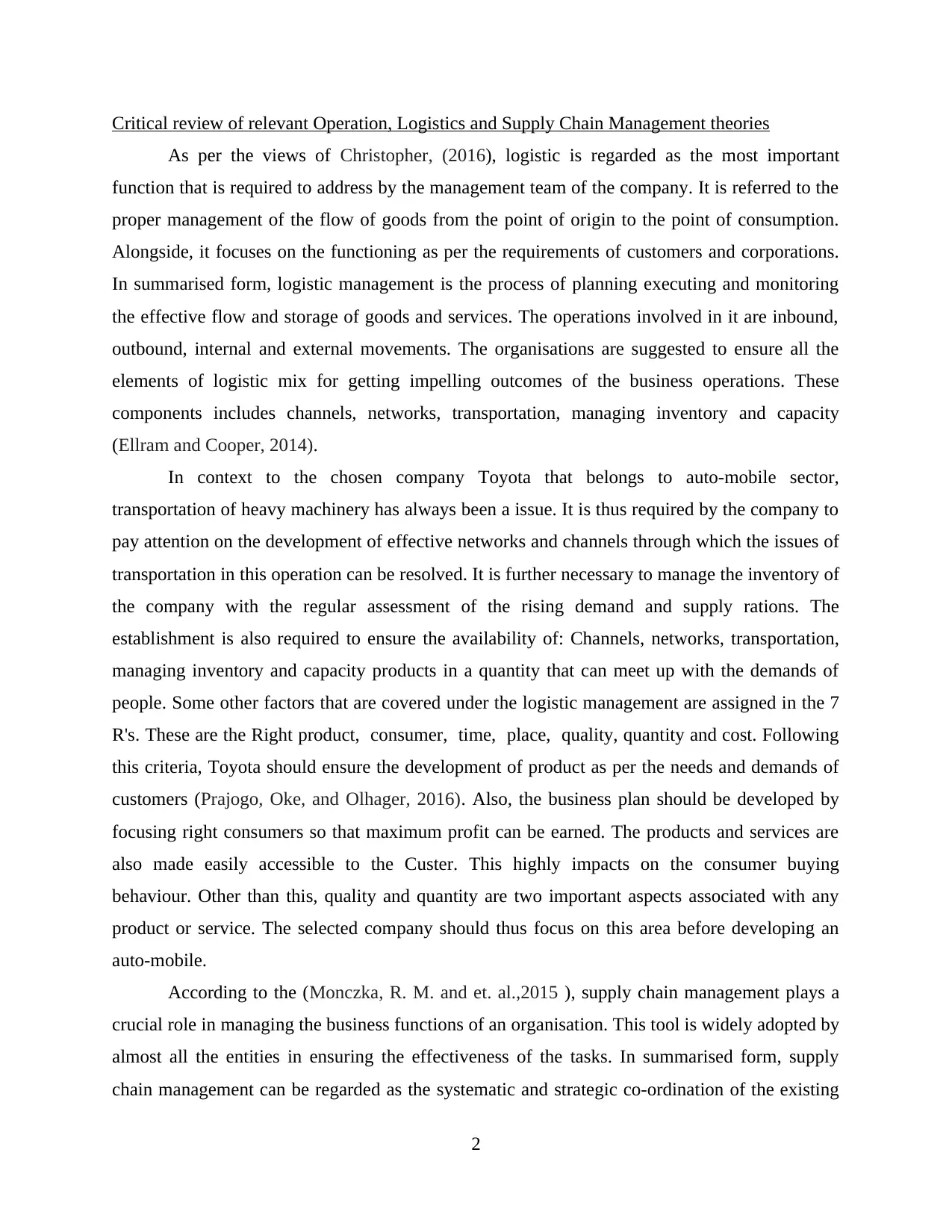
Critical review of relevant Operation, Logistics and Supply Chain Management theories
As per the views of Christopher, (2016), logistic is regarded as the most important
function that is required to address by the management team of the company. It is referred to the
proper management of the flow of goods from the point of origin to the point of consumption.
Alongside, it focuses on the functioning as per the requirements of customers and corporations.
In summarised form, logistic management is the process of planning executing and monitoring
the effective flow and storage of goods and services. The operations involved in it are inbound,
outbound, internal and external movements. The organisations are suggested to ensure all the
elements of logistic mix for getting impelling outcomes of the business operations. These
components includes channels, networks, transportation, managing inventory and capacity
(Ellram and Cooper, 2014).
In context to the chosen company Toyota that belongs to auto-mobile sector,
transportation of heavy machinery has always been a issue. It is thus required by the company to
pay attention on the development of effective networks and channels through which the issues of
transportation in this operation can be resolved. It is further necessary to manage the inventory of
the company with the regular assessment of the rising demand and supply rations. The
establishment is also required to ensure the availability of: Channels, networks, transportation,
managing inventory and capacity products in a quantity that can meet up with the demands of
people. Some other factors that are covered under the logistic management are assigned in the 7
R's. These are the Right product, consumer, time, place, quality, quantity and cost. Following
this criteria, Toyota should ensure the development of product as per the needs and demands of
customers (Prajogo, Oke, and Olhager, 2016). Also, the business plan should be developed by
focusing right consumers so that maximum profit can be earned. The products and services are
also made easily accessible to the Custer. This highly impacts on the consumer buying
behaviour. Other than this, quality and quantity are two important aspects associated with any
product or service. The selected company should thus focus on this area before developing an
auto-mobile.
According to the (Monczka, R. M. and et. al.,2015 ), supply chain management plays a
crucial role in managing the business functions of an organisation. This tool is widely adopted by
almost all the entities in ensuring the effectiveness of the tasks. In summarised form, supply
chain management can be regarded as the systematic and strategic co-ordination of the existing
2
As per the views of Christopher, (2016), logistic is regarded as the most important
function that is required to address by the management team of the company. It is referred to the
proper management of the flow of goods from the point of origin to the point of consumption.
Alongside, it focuses on the functioning as per the requirements of customers and corporations.
In summarised form, logistic management is the process of planning executing and monitoring
the effective flow and storage of goods and services. The operations involved in it are inbound,
outbound, internal and external movements. The organisations are suggested to ensure all the
elements of logistic mix for getting impelling outcomes of the business operations. These
components includes channels, networks, transportation, managing inventory and capacity
(Ellram and Cooper, 2014).
In context to the chosen company Toyota that belongs to auto-mobile sector,
transportation of heavy machinery has always been a issue. It is thus required by the company to
pay attention on the development of effective networks and channels through which the issues of
transportation in this operation can be resolved. It is further necessary to manage the inventory of
the company with the regular assessment of the rising demand and supply rations. The
establishment is also required to ensure the availability of: Channels, networks, transportation,
managing inventory and capacity products in a quantity that can meet up with the demands of
people. Some other factors that are covered under the logistic management are assigned in the 7
R's. These are the Right product, consumer, time, place, quality, quantity and cost. Following
this criteria, Toyota should ensure the development of product as per the needs and demands of
customers (Prajogo, Oke, and Olhager, 2016). Also, the business plan should be developed by
focusing right consumers so that maximum profit can be earned. The products and services are
also made easily accessible to the Custer. This highly impacts on the consumer buying
behaviour. Other than this, quality and quantity are two important aspects associated with any
product or service. The selected company should thus focus on this area before developing an
auto-mobile.
According to the (Monczka, R. M. and et. al.,2015 ), supply chain management plays a
crucial role in managing the business functions of an organisation. This tool is widely adopted by
almost all the entities in ensuring the effectiveness of the tasks. In summarised form, supply
chain management can be regarded as the systematic and strategic co-ordination of the existing
2
Paraphrase This Document
Need a fresh take? Get an instant paraphrase of this document with our AI Paraphraser
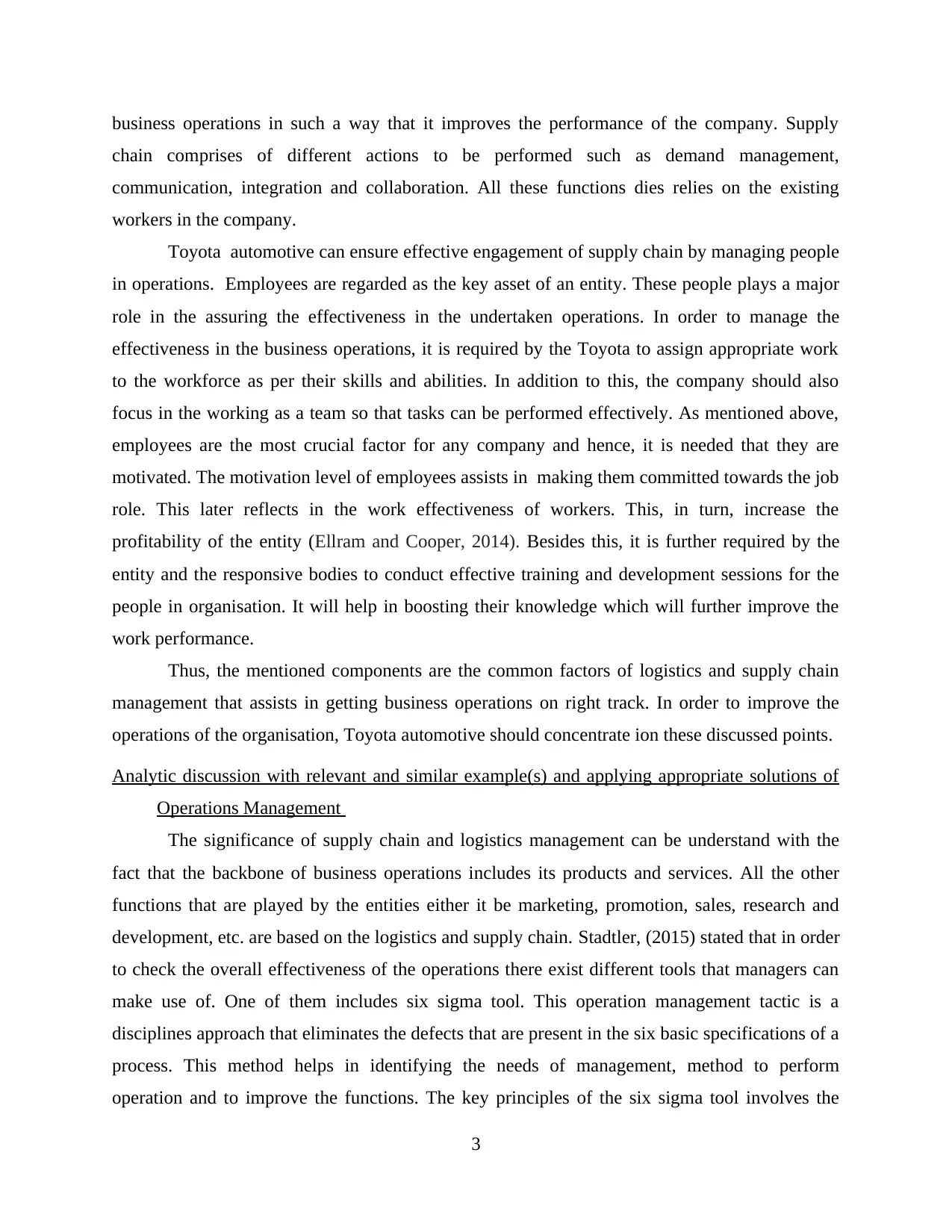
business operations in such a way that it improves the performance of the company. Supply
chain comprises of different actions to be performed such as demand management,
communication, integration and collaboration. All these functions dies relies on the existing
workers in the company.
Toyota automotive can ensure effective engagement of supply chain by managing people
in operations. Employees are regarded as the key asset of an entity. These people plays a major
role in the assuring the effectiveness in the undertaken operations. In order to manage the
effectiveness in the business operations, it is required by the Toyota to assign appropriate work
to the workforce as per their skills and abilities. In addition to this, the company should also
focus in the working as a team so that tasks can be performed effectively. As mentioned above,
employees are the most crucial factor for any company and hence, it is needed that they are
motivated. The motivation level of employees assists in making them committed towards the job
role. This later reflects in the work effectiveness of workers. This, in turn, increase the
profitability of the entity (Ellram and Cooper, 2014). Besides this, it is further required by the
entity and the responsive bodies to conduct effective training and development sessions for the
people in organisation. It will help in boosting their knowledge which will further improve the
work performance.
Thus, the mentioned components are the common factors of logistics and supply chain
management that assists in getting business operations on right track. In order to improve the
operations of the organisation, Toyota automotive should concentrate ion these discussed points.
Analytic discussion with relevant and similar example(s) and applying appropriate solutions of
Operations Management
The significance of supply chain and logistics management can be understand with the
fact that the backbone of business operations includes its products and services. All the other
functions that are played by the entities either it be marketing, promotion, sales, research and
development, etc. are based on the logistics and supply chain. Stadtler, (2015) stated that in order
to check the overall effectiveness of the operations there exist different tools that managers can
make use of. One of them includes six sigma tool. This operation management tactic is a
disciplines approach that eliminates the defects that are present in the six basic specifications of a
process. This method helps in identifying the needs of management, method to perform
operation and to improve the functions. The key principles of the six sigma tool involves the
3
chain comprises of different actions to be performed such as demand management,
communication, integration and collaboration. All these functions dies relies on the existing
workers in the company.
Toyota automotive can ensure effective engagement of supply chain by managing people
in operations. Employees are regarded as the key asset of an entity. These people plays a major
role in the assuring the effectiveness in the undertaken operations. In order to manage the
effectiveness in the business operations, it is required by the Toyota to assign appropriate work
to the workforce as per their skills and abilities. In addition to this, the company should also
focus in the working as a team so that tasks can be performed effectively. As mentioned above,
employees are the most crucial factor for any company and hence, it is needed that they are
motivated. The motivation level of employees assists in making them committed towards the job
role. This later reflects in the work effectiveness of workers. This, in turn, increase the
profitability of the entity (Ellram and Cooper, 2014). Besides this, it is further required by the
entity and the responsive bodies to conduct effective training and development sessions for the
people in organisation. It will help in boosting their knowledge which will further improve the
work performance.
Thus, the mentioned components are the common factors of logistics and supply chain
management that assists in getting business operations on right track. In order to improve the
operations of the organisation, Toyota automotive should concentrate ion these discussed points.
Analytic discussion with relevant and similar example(s) and applying appropriate solutions of
Operations Management
The significance of supply chain and logistics management can be understand with the
fact that the backbone of business operations includes its products and services. All the other
functions that are played by the entities either it be marketing, promotion, sales, research and
development, etc. are based on the logistics and supply chain. Stadtler, (2015) stated that in order
to check the overall effectiveness of the operations there exist different tools that managers can
make use of. One of them includes six sigma tool. This operation management tactic is a
disciplines approach that eliminates the defects that are present in the six basic specifications of a
process. This method helps in identifying the needs of management, method to perform
operation and to improve the functions. The key principles of the six sigma tool involves the
3
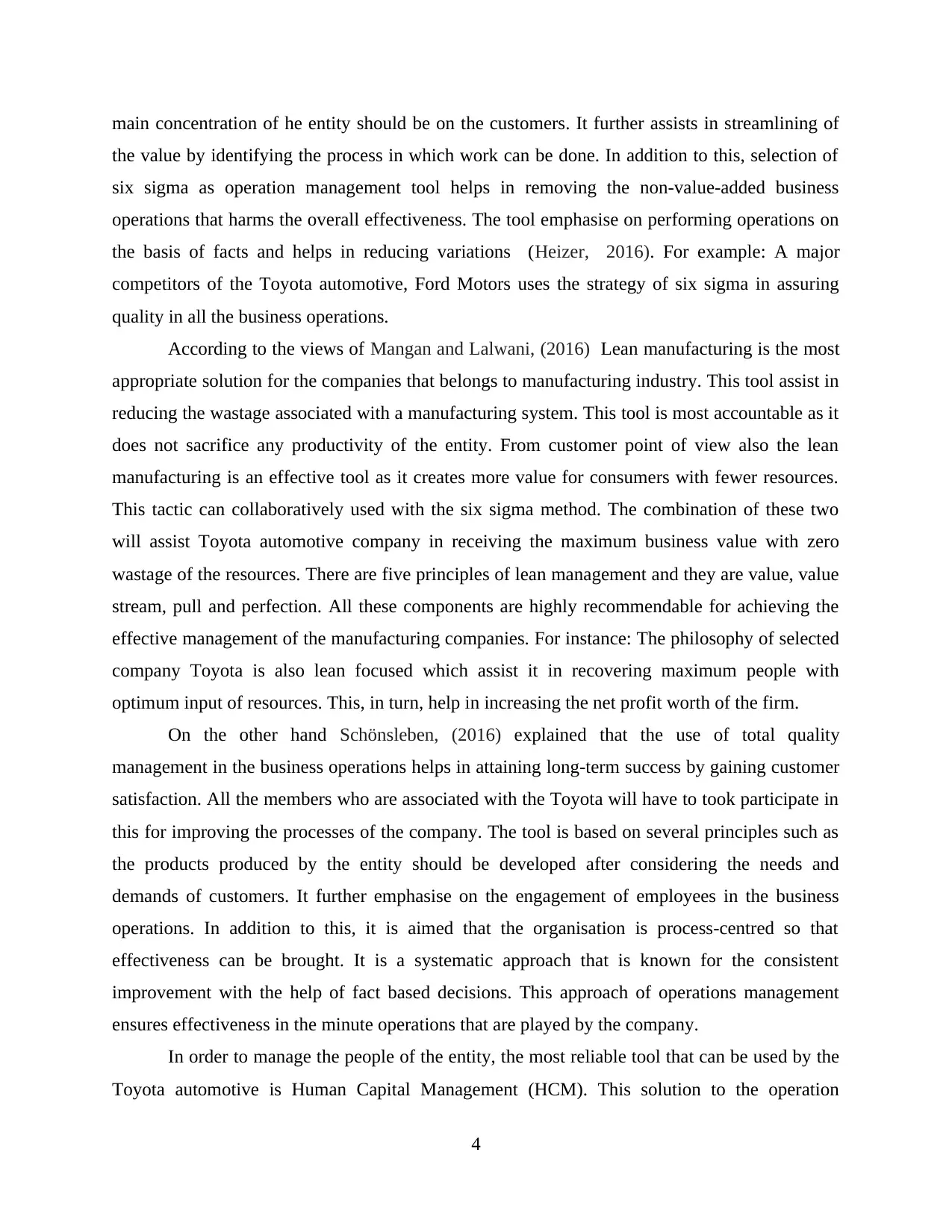
main concentration of he entity should be on the customers. It further assists in streamlining of
the value by identifying the process in which work can be done. In addition to this, selection of
six sigma as operation management tool helps in removing the non-value-added business
operations that harms the overall effectiveness. The tool emphasise on performing operations on
the basis of facts and helps in reducing variations (Heizer, 2016). For example: A major
competitors of the Toyota automotive, Ford Motors uses the strategy of six sigma in assuring
quality in all the business operations.
According to the views of Mangan and Lalwani, (2016) Lean manufacturing is the most
appropriate solution for the companies that belongs to manufacturing industry. This tool assist in
reducing the wastage associated with a manufacturing system. This tool is most accountable as it
does not sacrifice any productivity of the entity. From customer point of view also the lean
manufacturing is an effective tool as it creates more value for consumers with fewer resources.
This tactic can collaboratively used with the six sigma method. The combination of these two
will assist Toyota automotive company in receiving the maximum business value with zero
wastage of the resources. There are five principles of lean management and they are value, value
stream, pull and perfection. All these components are highly recommendable for achieving the
effective management of the manufacturing companies. For instance: The philosophy of selected
company Toyota is also lean focused which assist it in recovering maximum people with
optimum input of resources. This, in turn, help in increasing the net profit worth of the firm.
On the other hand Schönsleben, (2016) explained that the use of total quality
management in the business operations helps in attaining long-term success by gaining customer
satisfaction. All the members who are associated with the Toyota will have to took participate in
this for improving the processes of the company. The tool is based on several principles such as
the products produced by the entity should be developed after considering the needs and
demands of customers. It further emphasise on the engagement of employees in the business
operations. In addition to this, it is aimed that the organisation is process-centred so that
effectiveness can be brought. It is a systematic approach that is known for the consistent
improvement with the help of fact based decisions. This approach of operations management
ensures effectiveness in the minute operations that are played by the company.
In order to manage the people of the entity, the most reliable tool that can be used by the
Toyota automotive is Human Capital Management (HCM). This solution to the operation
4
the value by identifying the process in which work can be done. In addition to this, selection of
six sigma as operation management tool helps in removing the non-value-added business
operations that harms the overall effectiveness. The tool emphasise on performing operations on
the basis of facts and helps in reducing variations (Heizer, 2016). For example: A major
competitors of the Toyota automotive, Ford Motors uses the strategy of six sigma in assuring
quality in all the business operations.
According to the views of Mangan and Lalwani, (2016) Lean manufacturing is the most
appropriate solution for the companies that belongs to manufacturing industry. This tool assist in
reducing the wastage associated with a manufacturing system. This tool is most accountable as it
does not sacrifice any productivity of the entity. From customer point of view also the lean
manufacturing is an effective tool as it creates more value for consumers with fewer resources.
This tactic can collaboratively used with the six sigma method. The combination of these two
will assist Toyota automotive company in receiving the maximum business value with zero
wastage of the resources. There are five principles of lean management and they are value, value
stream, pull and perfection. All these components are highly recommendable for achieving the
effective management of the manufacturing companies. For instance: The philosophy of selected
company Toyota is also lean focused which assist it in recovering maximum people with
optimum input of resources. This, in turn, help in increasing the net profit worth of the firm.
On the other hand Schönsleben, (2016) explained that the use of total quality
management in the business operations helps in attaining long-term success by gaining customer
satisfaction. All the members who are associated with the Toyota will have to took participate in
this for improving the processes of the company. The tool is based on several principles such as
the products produced by the entity should be developed after considering the needs and
demands of customers. It further emphasise on the engagement of employees in the business
operations. In addition to this, it is aimed that the organisation is process-centred so that
effectiveness can be brought. It is a systematic approach that is known for the consistent
improvement with the help of fact based decisions. This approach of operations management
ensures effectiveness in the minute operations that are played by the company.
In order to manage the people of the entity, the most reliable tool that can be used by the
Toyota automotive is Human Capital Management (HCM). This solution to the operation
4
⊘ This is a preview!⊘
Do you want full access?
Subscribe today to unlock all pages.

Trusted by 1+ million students worldwide
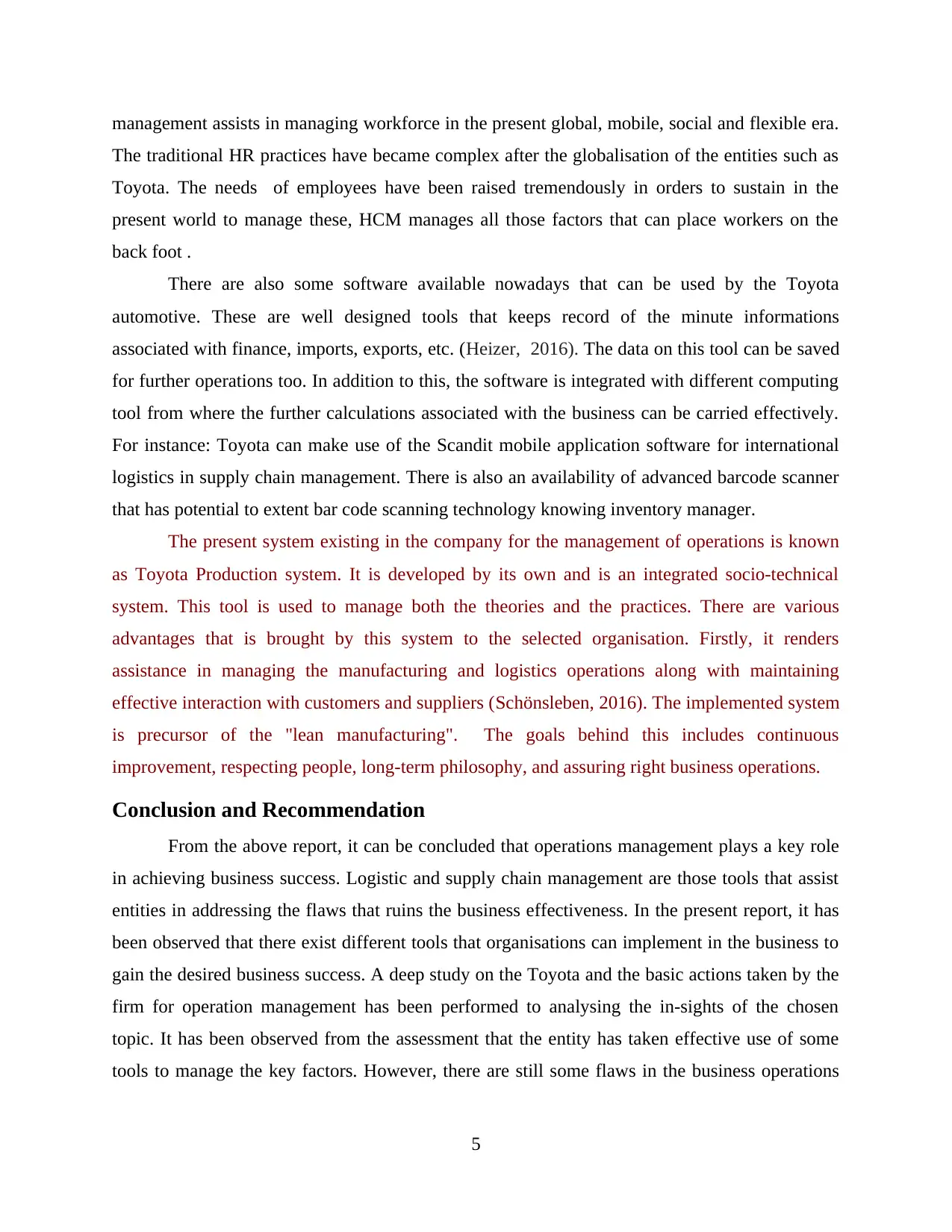
management assists in managing workforce in the present global, mobile, social and flexible era.
The traditional HR practices have became complex after the globalisation of the entities such as
Toyota. The needs of employees have been raised tremendously in orders to sustain in the
present world to manage these, HCM manages all those factors that can place workers on the
back foot .
There are also some software available nowadays that can be used by the Toyota
automotive. These are well designed tools that keeps record of the minute informations
associated with finance, imports, exports, etc. (Heizer, 2016). The data on this tool can be saved
for further operations too. In addition to this, the software is integrated with different computing
tool from where the further calculations associated with the business can be carried effectively.
For instance: Toyota can make use of the Scandit mobile application software for international
logistics in supply chain management. There is also an availability of advanced barcode scanner
that has potential to extent bar code scanning technology knowing inventory manager.
The present system existing in the company for the management of operations is known
as Toyota Production system. It is developed by its own and is an integrated socio-technical
system. This tool is used to manage both the theories and the practices. There are various
advantages that is brought by this system to the selected organisation. Firstly, it renders
assistance in managing the manufacturing and logistics operations along with maintaining
effective interaction with customers and suppliers (Schönsleben, 2016). The implemented system
is precursor of the "lean manufacturing". The goals behind this includes continuous
improvement, respecting people, long-term philosophy, and assuring right business operations.
Conclusion and Recommendation
From the above report, it can be concluded that operations management plays a key role
in achieving business success. Logistic and supply chain management are those tools that assist
entities in addressing the flaws that ruins the business effectiveness. In the present report, it has
been observed that there exist different tools that organisations can implement in the business to
gain the desired business success. A deep study on the Toyota and the basic actions taken by the
firm for operation management has been performed to analysing the in-sights of the chosen
topic. It has been observed from the assessment that the entity has taken effective use of some
tools to manage the key factors. However, there are still some flaws in the business operations
5
The traditional HR practices have became complex after the globalisation of the entities such as
Toyota. The needs of employees have been raised tremendously in orders to sustain in the
present world to manage these, HCM manages all those factors that can place workers on the
back foot .
There are also some software available nowadays that can be used by the Toyota
automotive. These are well designed tools that keeps record of the minute informations
associated with finance, imports, exports, etc. (Heizer, 2016). The data on this tool can be saved
for further operations too. In addition to this, the software is integrated with different computing
tool from where the further calculations associated with the business can be carried effectively.
For instance: Toyota can make use of the Scandit mobile application software for international
logistics in supply chain management. There is also an availability of advanced barcode scanner
that has potential to extent bar code scanning technology knowing inventory manager.
The present system existing in the company for the management of operations is known
as Toyota Production system. It is developed by its own and is an integrated socio-technical
system. This tool is used to manage both the theories and the practices. There are various
advantages that is brought by this system to the selected organisation. Firstly, it renders
assistance in managing the manufacturing and logistics operations along with maintaining
effective interaction with customers and suppliers (Schönsleben, 2016). The implemented system
is precursor of the "lean manufacturing". The goals behind this includes continuous
improvement, respecting people, long-term philosophy, and assuring right business operations.
Conclusion and Recommendation
From the above report, it can be concluded that operations management plays a key role
in achieving business success. Logistic and supply chain management are those tools that assist
entities in addressing the flaws that ruins the business effectiveness. In the present report, it has
been observed that there exist different tools that organisations can implement in the business to
gain the desired business success. A deep study on the Toyota and the basic actions taken by the
firm for operation management has been performed to analysing the in-sights of the chosen
topic. It has been observed from the assessment that the entity has taken effective use of some
tools to manage the key factors. However, there are still some flaws in the business operations
5
Paraphrase This Document
Need a fresh take? Get an instant paraphrase of this document with our AI Paraphraser
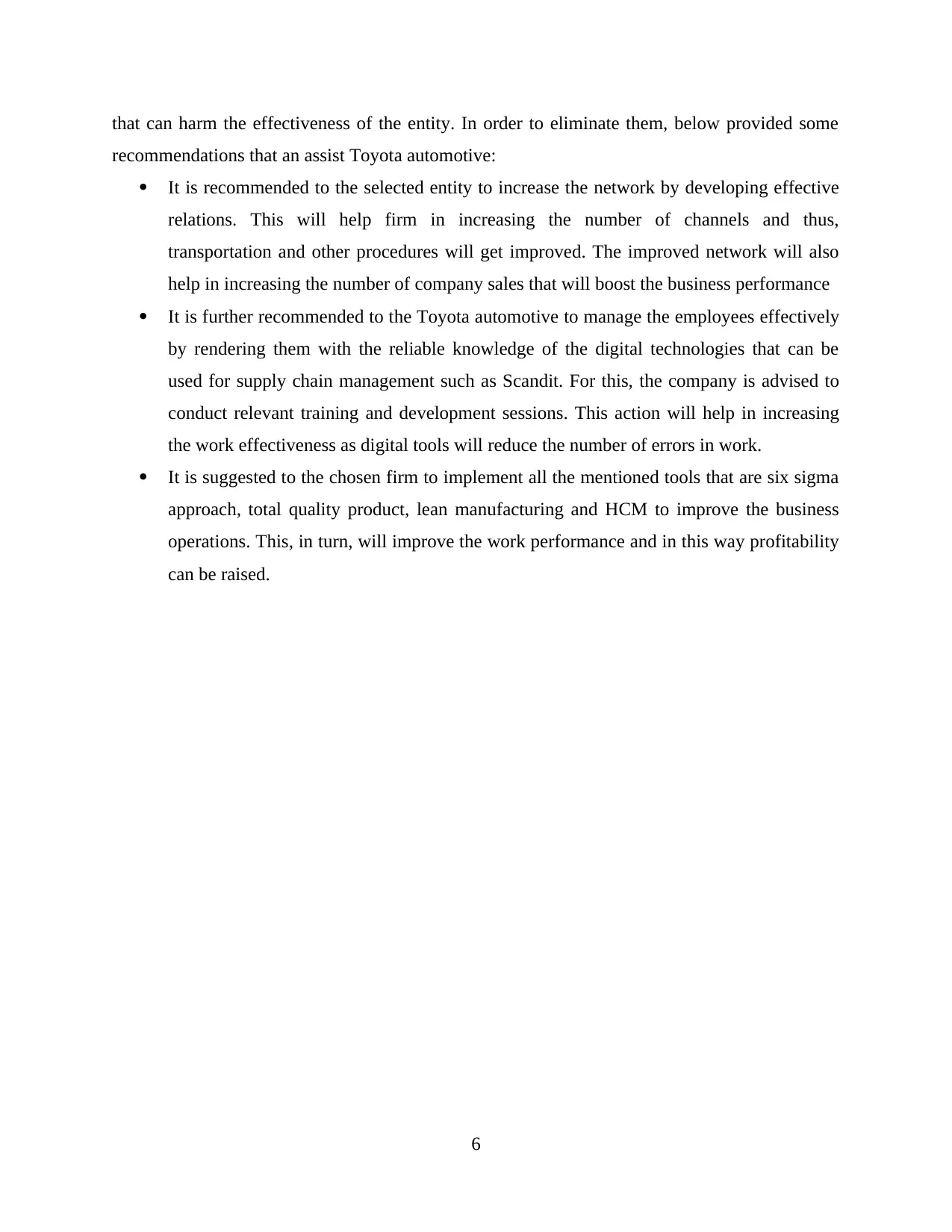
that can harm the effectiveness of the entity. In order to eliminate them, below provided some
recommendations that an assist Toyota automotive:
It is recommended to the selected entity to increase the network by developing effective
relations. This will help firm in increasing the number of channels and thus,
transportation and other procedures will get improved. The improved network will also
help in increasing the number of company sales that will boost the business performance
It is further recommended to the Toyota automotive to manage the employees effectively
by rendering them with the reliable knowledge of the digital technologies that can be
used for supply chain management such as Scandit. For this, the company is advised to
conduct relevant training and development sessions. This action will help in increasing
the work effectiveness as digital tools will reduce the number of errors in work.
It is suggested to the chosen firm to implement all the mentioned tools that are six sigma
approach, total quality product, lean manufacturing and HCM to improve the business
operations. This, in turn, will improve the work performance and in this way profitability
can be raised.
6
recommendations that an assist Toyota automotive:
It is recommended to the selected entity to increase the network by developing effective
relations. This will help firm in increasing the number of channels and thus,
transportation and other procedures will get improved. The improved network will also
help in increasing the number of company sales that will boost the business performance
It is further recommended to the Toyota automotive to manage the employees effectively
by rendering them with the reliable knowledge of the digital technologies that can be
used for supply chain management such as Scandit. For this, the company is advised to
conduct relevant training and development sessions. This action will help in increasing
the work effectiveness as digital tools will reduce the number of errors in work.
It is suggested to the chosen firm to implement all the mentioned tools that are six sigma
approach, total quality product, lean manufacturing and HCM to improve the business
operations. This, in turn, will improve the work performance and in this way profitability
can be raised.
6
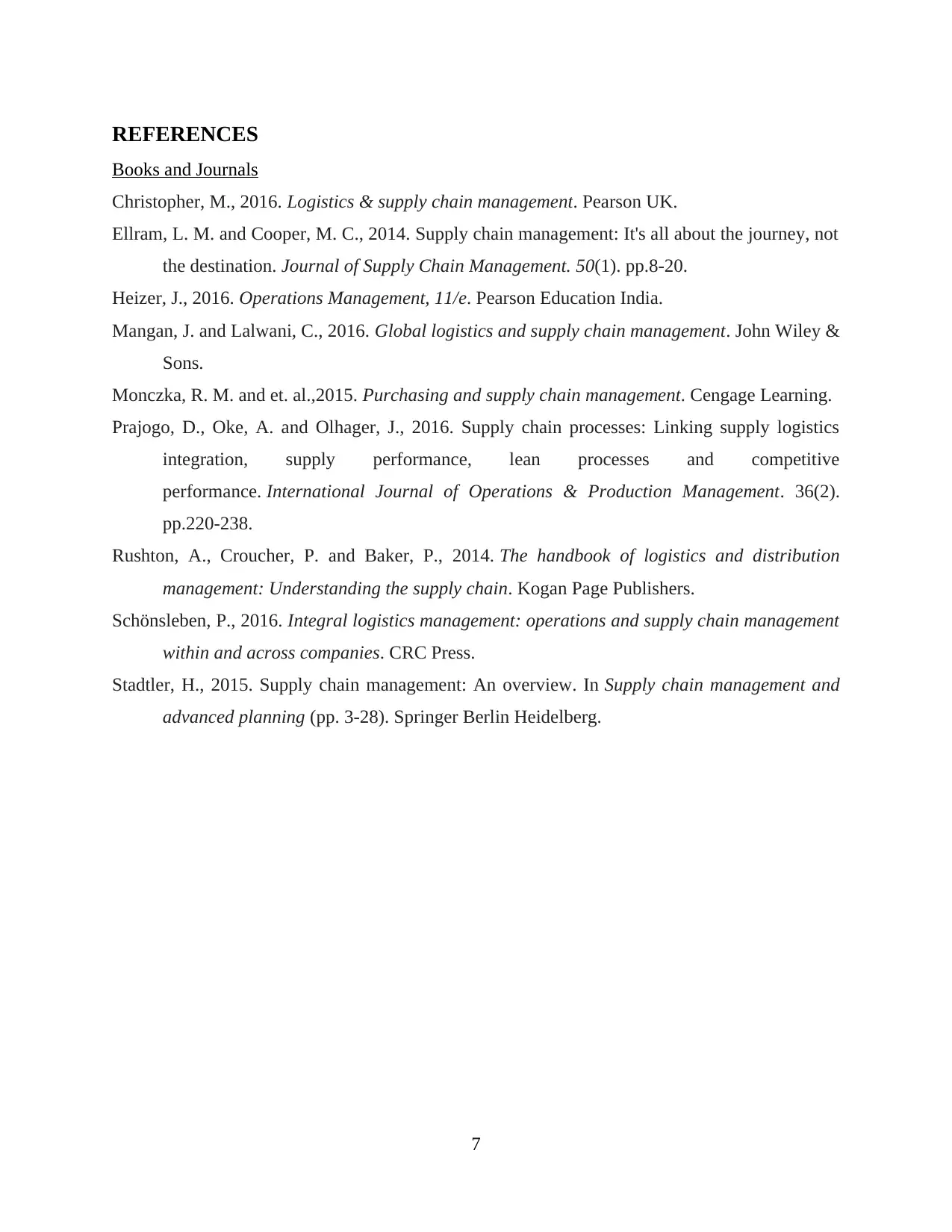
REFERENCES
Books and Journals
Christopher, M., 2016. Logistics & supply chain management. Pearson UK.
Ellram, L. M. and Cooper, M. C., 2014. Supply chain management: It's all about the journey, not
the destination. Journal of Supply Chain Management. 50(1). pp.8-20.
Heizer, J., 2016. Operations Management, 11/e. Pearson Education India.
Mangan, J. and Lalwani, C., 2016. Global logistics and supply chain management. John Wiley &
Sons.
Monczka, R. M. and et. al.,2015. Purchasing and supply chain management. Cengage Learning.
Prajogo, D., Oke, A. and Olhager, J., 2016. Supply chain processes: Linking supply logistics
integration, supply performance, lean processes and competitive
performance. International Journal of Operations & Production Management. 36(2).
pp.220-238.
Rushton, A., Croucher, P. and Baker, P., 2014. The handbook of logistics and distribution
management: Understanding the supply chain. Kogan Page Publishers.
Schönsleben, P., 2016. Integral logistics management: operations and supply chain management
within and across companies. CRC Press.
Stadtler, H., 2015. Supply chain management: An overview. In Supply chain management and
advanced planning (pp. 3-28). Springer Berlin Heidelberg.
7
Books and Journals
Christopher, M., 2016. Logistics & supply chain management. Pearson UK.
Ellram, L. M. and Cooper, M. C., 2014. Supply chain management: It's all about the journey, not
the destination. Journal of Supply Chain Management. 50(1). pp.8-20.
Heizer, J., 2016. Operations Management, 11/e. Pearson Education India.
Mangan, J. and Lalwani, C., 2016. Global logistics and supply chain management. John Wiley &
Sons.
Monczka, R. M. and et. al.,2015. Purchasing and supply chain management. Cengage Learning.
Prajogo, D., Oke, A. and Olhager, J., 2016. Supply chain processes: Linking supply logistics
integration, supply performance, lean processes and competitive
performance. International Journal of Operations & Production Management. 36(2).
pp.220-238.
Rushton, A., Croucher, P. and Baker, P., 2014. The handbook of logistics and distribution
management: Understanding the supply chain. Kogan Page Publishers.
Schönsleben, P., 2016. Integral logistics management: operations and supply chain management
within and across companies. CRC Press.
Stadtler, H., 2015. Supply chain management: An overview. In Supply chain management and
advanced planning (pp. 3-28). Springer Berlin Heidelberg.
7
⊘ This is a preview!⊘
Do you want full access?
Subscribe today to unlock all pages.

Trusted by 1+ million students worldwide
1 out of 9
Related Documents
Your All-in-One AI-Powered Toolkit for Academic Success.
+13062052269
info@desklib.com
Available 24*7 on WhatsApp / Email
![[object Object]](/_next/static/media/star-bottom.7253800d.svg)
Unlock your academic potential
Copyright © 2020–2025 A2Z Services. All Rights Reserved. Developed and managed by ZUCOL.




